If you’re following a low carb or ketogenic diet you need to read this.
This is the most thorough guide to keto electrolytes online.
You’ll learn why it’s essential to monitor electrolytes, foods rich in different electrolytes, and much more.
Don't have time to read all 4,000 words? Download a PDF to read offline at a later time.
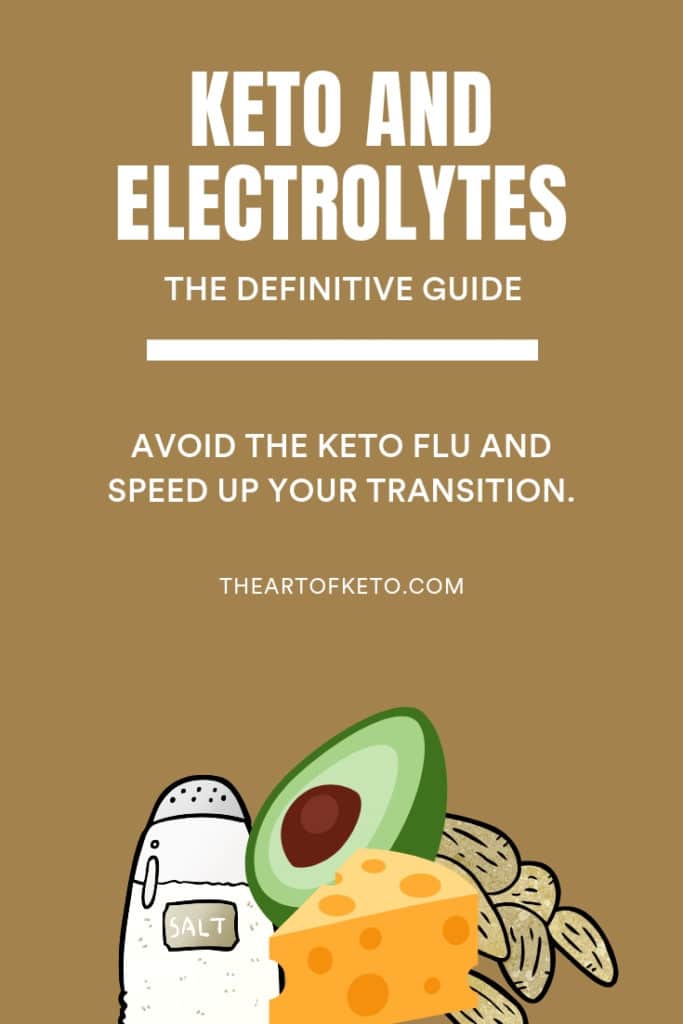
Table of Contents
CHAPTER 1: Electrolyte Basics
One of the most common, yet unpleasant, side effects when starting a ketogenic diet that you may… or perhaps have already experienced is the “keto flu.”The keto flu is just as it sounds… it will literally feel as though you are suffering from the flu. If you’ve experienced tiredness, fatigue, dizziness, and bouts of lightheadedness, then these are some of the common symptoms that may indicate you are deficient in ELECTROLYTES.
What are electrolytes?
Electrolytes are natural minerals found in the body and are important for controlling many of our body’s physiologic functions. Electrolytes need to be balanced for our body to function correctly. If one or more of these electrolytes are severely deficient, you’re going to end up in a world of hurt.
The most essential keto electrolytes we cover in this guide are:
- Sodium
- Magnesium
- Potassium
- Calcium
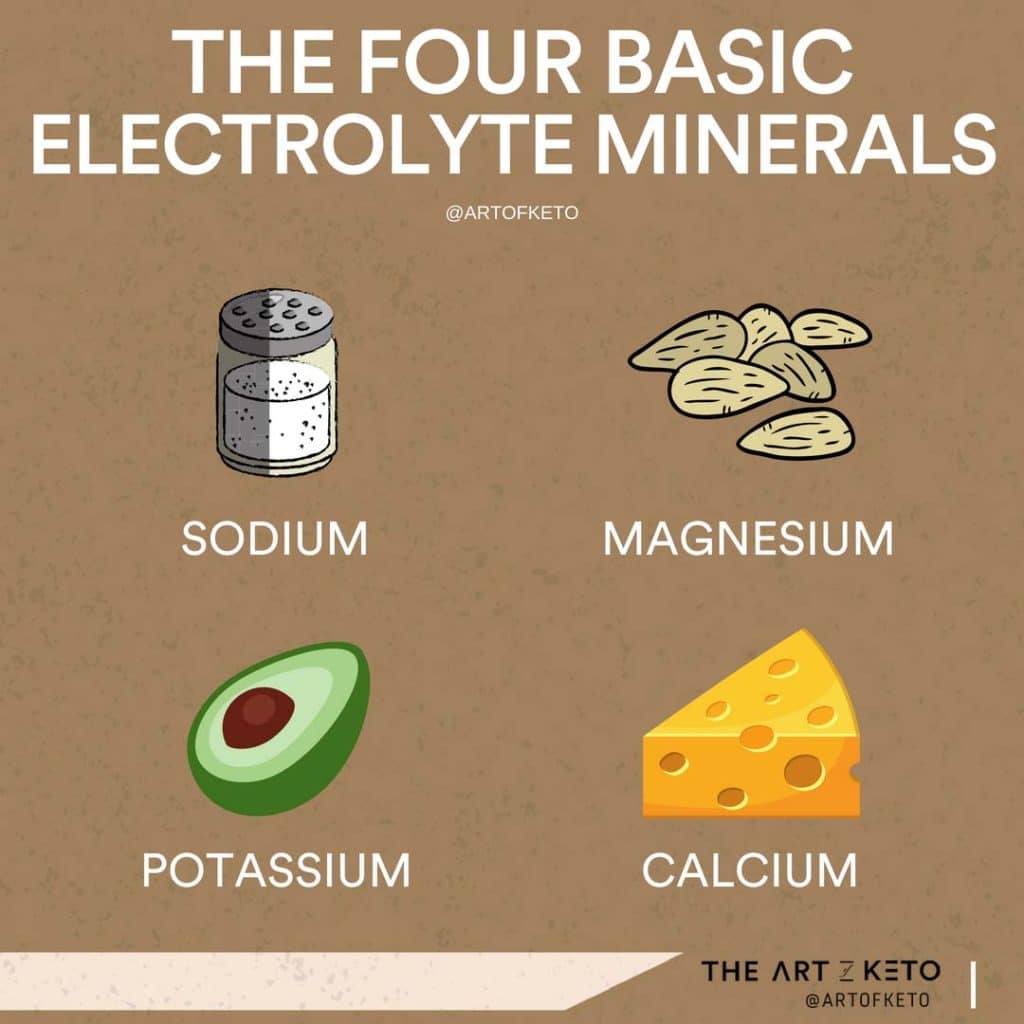
These essential keto electrolytes are present in your blood, bodily fluids (like sweat), urine, and are crucial for important functions like:
- Regulating heartbeat
- Contracting your muscles
- Bladder control
- Body temperature control
Why are electrolytes on keto more important?
While not always the case, many of the unpleasant feelings that come about on a ketogenic diet are due to a lack of certain or all electrolytes, most notably sodium, potassium, and or magnesium.
Part of the reason it’s important to monitor your electrolytes on a low carb, or ketogenic diet is that when you drastically cut carbs, glycogen stores (stored carbs) are lowered. For every gram of glycogen, your body also stores three grams of water. Hence, when you restrict carbohydrates, you will tend to see a rapid loss of water and weight during the first few days of transitioning to a ketogenic diet.
Additionally, it seems that ketones themselves have a diuretic effect causing excretion of water and electrolytes,1 so it’s like a double whammy. You can see why it’s important to not only increase your water intake but replace the lost electrolytes that are excreted.
Lastly, when insulin levels are kept low, which is the case on a ketogenic diet, the kidney excretes sodium at an increased rate.
In this guide, we’ll go over each of the electrolytes you should be paying attention to, why they’re important, and the best way to replenish them on a ketogenic diet.
Some common symptoms of electrolyte deficiency
Not all electrolyte deficiencies cause the same symptoms, but they do share some similarities. This is what makes pinpointing the specific electrolyte deficiency hard unless you get your blood levels checked to identify the problem.
Some common symptoms of an electrolyte deficiency include:
- Lethargy
- Irregular heartbeat
- Nausea
- Diarrhea or constipation
- Muscle weakness
- Muscle cramping
- Irritability
- Headaches
- Numbness and tingling
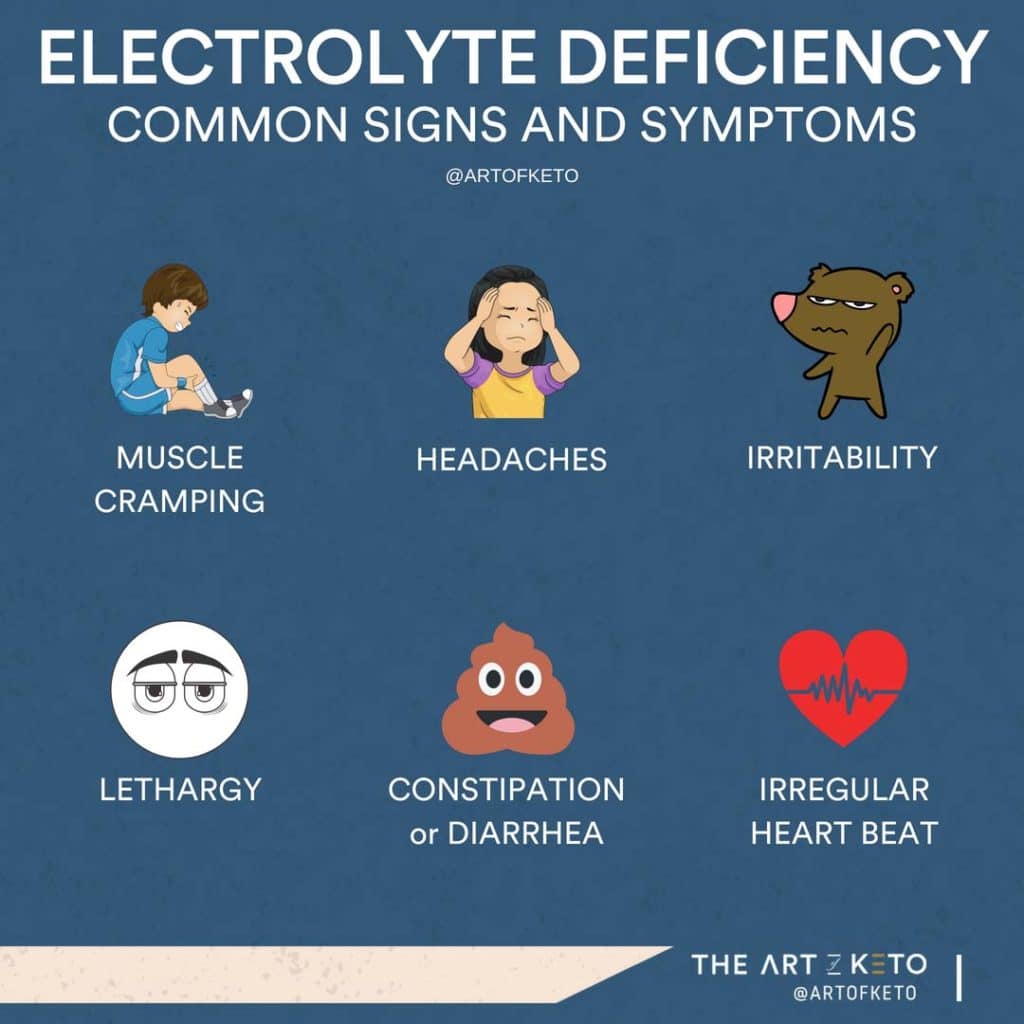
If you are experiencing one or more of these symptoms, you might be suffering from an electrolyte imbalance which shares the same characteristics as the keto flu. Electrolyte deficiencies have the possibility of becoming life-threatening if left untreated, so be sure to take proper precautions.
CHAPTER 2: Sodium
Sodium has received a bad rap in the past.
I’m sure you’ve heard or even been told that you should avoid adding sodium to your diet. However, since you’re on a ketogenic diet, your body needs EXTRA sodium.
What is sodium?
Many people often confuse sodium with salt and salt for sodium. While salt is the most common way we get sodium in our diets, table salt is composed of two minerals sodium (Na) and chloride (Cl). Table salt contains 40% sodium and 60% chloride with one teaspoon of salt containing about 2,300 mg of sodium
Why we need sodium and how much we need
Sodium helps to balance bodily fluids, regulate blood pressure, and contract muscles among many other essential bodily functions. Simply put, the human body cannot live without some sodium.
The Recommended Daily Allowance (RDA) for sodium is 1500 – 2300mg, which is about 1tsp or 6g of salt a day.
Three major health organizations recommended intake of sodium:
- (USDA) United States Department of Agriculture: 2,300mg per day
- (AHA) American Heart Association: 1,500mg per day
- (ADA) American Diabetes Association: 1,500 to 2,300mg per day
The problem with these recommendations is that they are based on a high carb, high calorie, high processed food diet. If your diet is full of whole, unprocessed foods without a ton of added sodium, then you can safely aim for anywhere from 4000 – 7000mg of sodium per day.
When I say processed, think of canned foods or boxed meals. Even keto friendly foods like vienna sausages or spam fall into this category.
- Read: Is Spam Keto?
- Read: Is Vienna Sausages Keto?
Keto electrolyte requirements for sodium
As stated, you should aim for anywhere from 4,000 – 7,000mg of sodium. This comes out to somewhere around 3 tsp or 15 – 18g of salt. Your individual sodium requirement will depend significantly on your activity levels and how much you sweat.
If you’re an athlete or tend to sweat a lot because of exercise or even sauna use, then you should definitely aim for the higher end of the spectrum. However, if you’re sedentary or don’t tend to sweat, then you can probably stick with the low end of that range.
Health benefits of salt
- May improve exercise performance. This is a big reason why I recommend taking in 1 – 2g of salt pre-workout. Not only will it help with achieving the pump many feel lost on a ketogenic diet, but it will help replace or offset the electrolytes lost during vigorous exercise and other diuretics such as coffee.
- Help improve or eliminate “keto flu.” When transitioning to a ketogenic diet, people often report feelings of dizziness, headaches, and low energy. Increasing your sodium will often diminish those feelings or even eliminate them altogether.
- May improve fat loss. Yepp, you read that correctly. Sodium plays a large role in metabolic health and fat loss by reducing insulin levels.
How to get more sodium on a ketogenic diet
Many foods contain small amounts of sodium naturally, but most of the sodium in the diet will come from salt. So out of all the other electrolytes, getting additional sodium is simple…
Just salt your foods liberally…
And to taste!
I recommend using salts such as Redmond real salt, pink Himalayan salt or Celtic sea salt because they contain additional minerals like magnesium, which is another important electrolyte.
- Recommended salt: Redmond real salt
- Recommended salt: Celtic sea salt
- Recommended salt: Pink himalayan salt
You can also replenish your sodium by adding salt to your water, making sole water, or regularly drinking things like chicken stock.
Another favorite is to make homemade bone broth, or if you’re like me and not that kitchen savvy (ok lazy) or prefer to buy it prepared, I would recommend Kettle and Fire which carries delicious bone broth ready to sip.
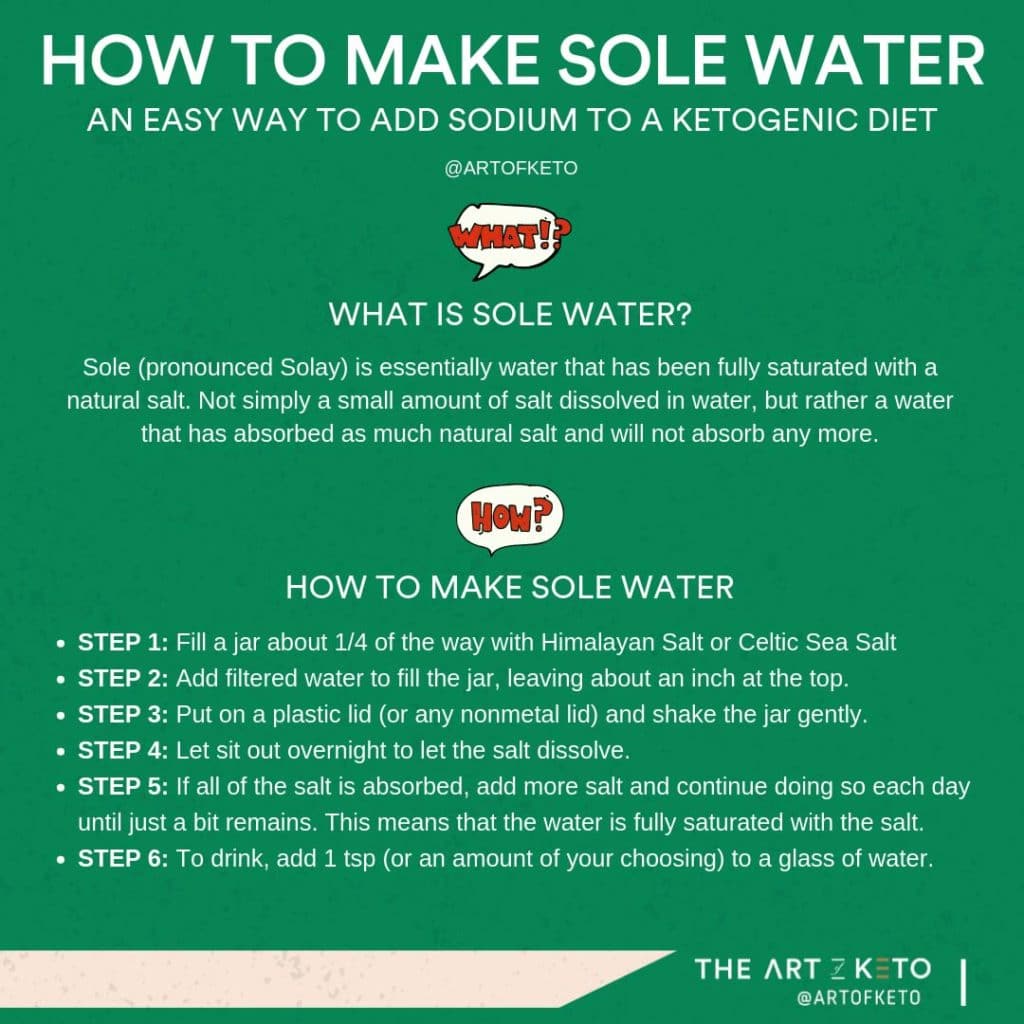
The sodium summary
Sodium is probably the most crucial electrolyte as it helps retain water in the body and also regulates the other electrolytes. As far as how much salt to eat on a ketogenic diet, a good rule of thumb is to get a minimum of 4,000 mg of sodium a day. However, if you’re physically active or sweat a lot, then you should aim for at almost double that.
If you’re interested in learning more about salt and why it’s way more important than you once might have thought, a great book on the subject is The Salt Fix by Dr. James DiNicolantonio.
CHAPTER 3: Potassium
What is potassium?
Potassium is the third most abundant electrolyte found in your body.
Potassium helps regulate bodily functions like your heartbeat, so heart palpitations and swelling are typically correlated with a potassium deficiency.
Why is potassium important?
Potassium helps regulate fluid balance. Along with sodium, potassium is responsible for maintaining fluid balance within our bodies. Since our bodies are made of approximately 60% water, you can see why this would be very important.
Now, 40% of this water is found within our cells in a substance referred to as intracellular fluid. Potassium is the primary electrolyte that governs our intracellular fluid.
Necessary for the nervous system. Getting in enough potassium will help maintain healthy nerve function. Nerve impulses in our bodies are what help regulate things like muscle contractions, heartbeat, and various other processes.
Since potassium levels have a significant effect on muscle contractions, low levels can lead to muscle weakness, and in the heart, this may cause an irregular heartbeat.
As you may be able to tell already, potassium and sodium are very closely tied together. I thought it may be important to help explain this a bit further.
The sodium-potassium pump
What most people don’t realize is that your body’s potassium stores are controlled by your sodium intake via the sodium-potassium pump. This is another reason why an adequate intake of sodium is crucial to maintaining proper electrolyte balance.
Much like ketones and carbohydrates are muscle sparing, sodium is potassium sparing. Meaning, If you get in enough sodium, you don’t have to worry so much about potassium so long as you are getting in between 2,000 – 4,000 mg per day. Much like sodium, the more physically active you are and/or sweat the higher in the spectrum you should go.
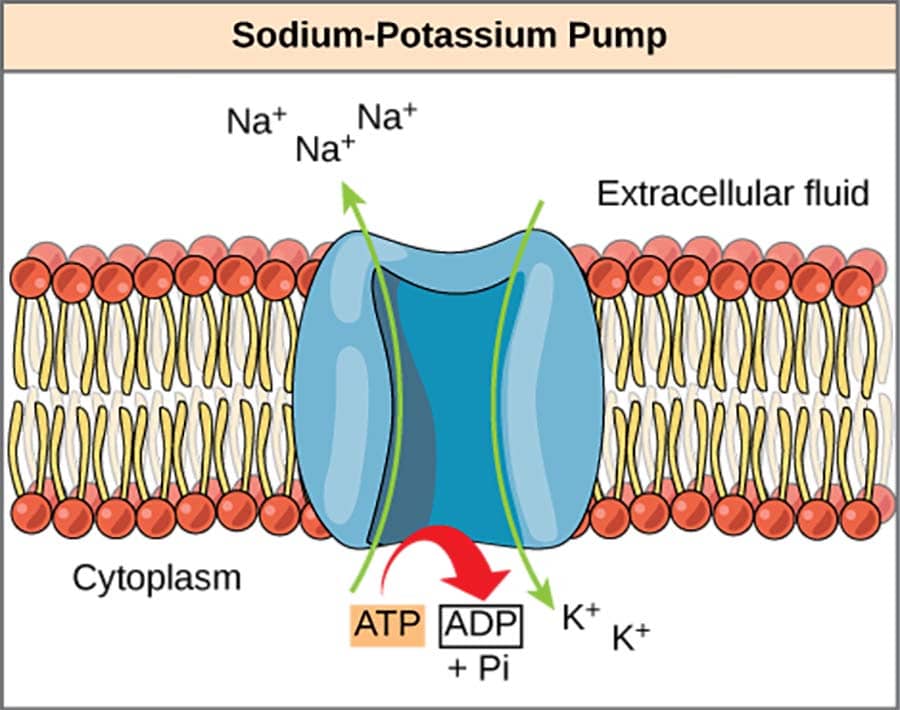
The function of the sodium-potassium pump is to help move fluids in and out of your cells. This allows blood to circulate, helps pump our heart, and allows messages to be delivered
How do you know if you are deficient in potassium?
Signs you may be deficient in potassium include:
- Fatigue
- Heart palpitations
- Insomnia
- Dehydration
- Constipation
- Muscle cramps
Many of the same deficiency signs of potassium share their similarities with sodium and/or magnesium deficiency which makes it hard to pinpoint precisely. Again, the only soundproof method is to have your electrolyte levels checked via a blood draw.
Of course, you can always experiment and add in varying levels of one electrolyte over another depending if you know you’re already consuming adequate amounts of the other electrolytes. Then, it just becomes a wait and see to track whether or not the symptoms you are experiencing lessen or go away altogether.
Granted, if it persists or even worsens, you may want to go ahead and get it checked out by your doctor before it turns into something more serious and potentially even lethal.
Our bodies are usually great at regulating potassium levels on their own, but certain health conditions can lead to a higher risk of developing a potassium deficiency:
- Alcoholism
- Diabetes
- Kidney disease
Can you have too much potassium?
It is quite rare to overdose on potassium assuming you are obtaining most, if not all of it, from naturally occurring sources (whole foods). The exception to this if you suffer from a pre-existing medical condition or kidney problem.
Keto electrolyte requirements for potassium
As stated, you should aim for between 2,000 – 4,000 mg of potassium per day. The general RDA for potassium is between 1,000 – 4,700 mg per day. Of course, we recommend you stick to the higher end, the more you sweat and the more active you are, which of course tends to go hand in hand most of the time.
Different organizations recommended intake of potassium:
- (NHANES) National Health and Nutrition Examination Survey: 4,700mg per day
- (WHO) World Health Organization: 3,510 mg per day
What are the health benefits of potassium?
My top 3 health benefits of potassium
Blood pressure and cardiovascular health. Low potassium intake has been linked to high blood pressure and cardiovascular disease. In one study, those who consumed roughly 4,000mg of potassium per day compared to those who consumed 1,000 mg per day had a 49 percent lower risk of death from ischemic heart disease. 2
Keeps bones strong and helps maintain muscle. Some studies show an increase in bone density with high potassium intake. Also, one study found that participants that took in around 5,000 mg of potassium per day maintained an average of 3.6 pounds of lean mass MORE than those with a potassium intake of around half that. 3
Reduces the chance of kidney stones. Potassium-rich foods maintain an alkaline environment within the body creating a less welcoming environment for kidney stones to nest. Potassium also binds with calcium, thus not allowing calcium the chance to bind with other minerals and form kidney stones.
So now that you understand the importance of potassium let’s go over what foods to include in your diet to meet your needs.
What keto friendly foods are high in potassium?
Bananas are probably the most popular source of potassium with about 420mg for a medium sized banana. However, there are much better and lower carbohydrate sources of potassium to be had.
Here are some of my favorites:
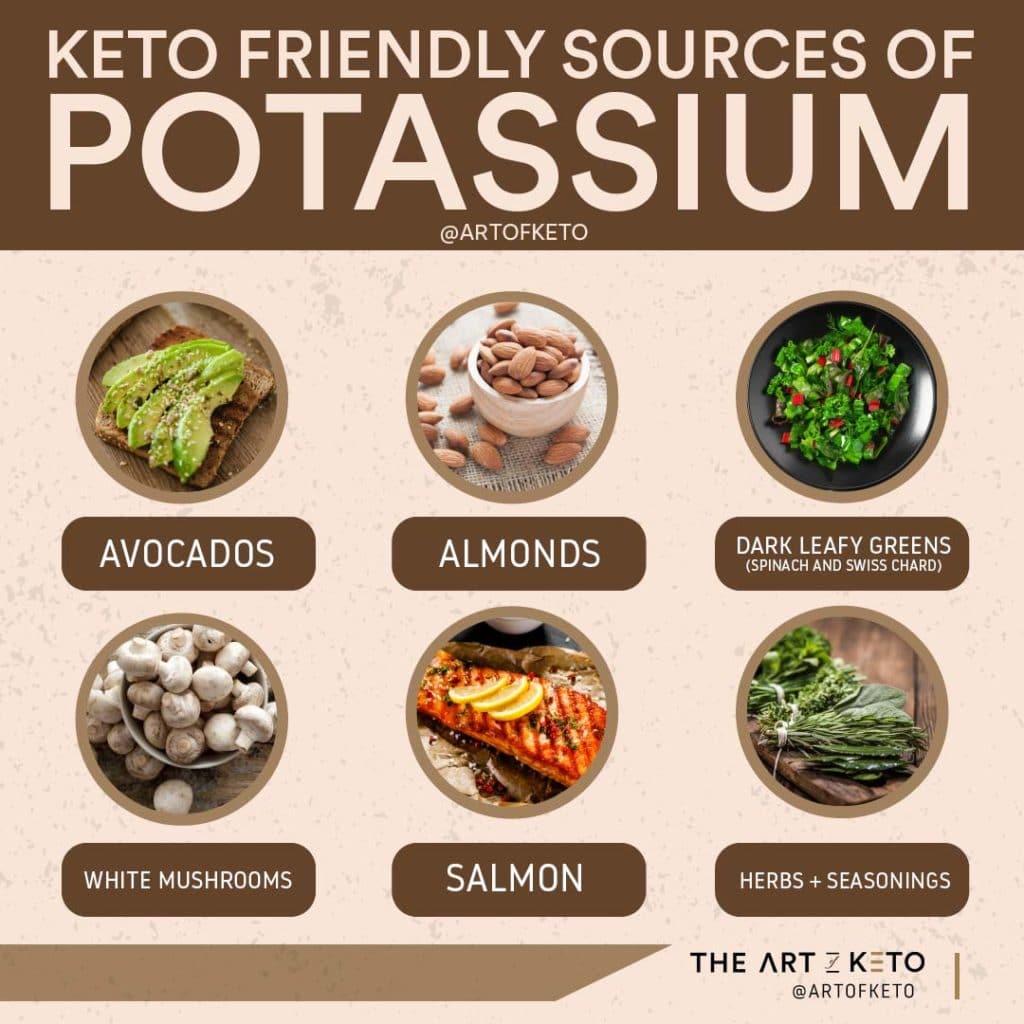
AVOCADO
Everyone’s favorite keto-friendly fruit full of healthy fats. Avocados are indeed a superfood and one of the best sources of potassium for many individuals on a ketogenic diet.
One medium avocado provides a whopping 690 mg of potassium.
BEEF
Yes, you read that correctly… BEEF is an excellent source of potassium! Besides tasting delicious, a 4 oz steak provides almost 384 mg of potassium.
MUSHROOMS
One of my favorite vegetables on the planet. Mushrooms are rich in vitamin b12, a great antioxidant, and of course… high in potassium.
Cremini mushrooms have the highest amount of potassium per volume with 1 cup coming in at 323 mg.
BRUSSEL SPROUTS
Who doesn’t love some oven roasted Brussel sprouts with bacon? One cup of cooked Brussel sprouts gives you a whopping 494 mg of potassium. Not to mention, you get 4g of protein and 4g of fiber on the side.
SPINACH AND LEAFY GREENS
I think Popeye was onto something because you get all three electrolytes (potassium, magnesium, and sodium) in spinach.
One cup of cooked spinach delivers a significant amount of potassium at 839 mg.
SALMON
When people think of salmon, they think of omega 3’s, but salmon is also packed full of essential nutrients and a great source of B vitamins.
A 3 oz serving of salmon provides 416 mg of potassium.
CAULIFLOWER
Everyone’s favorite keto-friendly vegetable to make everything from mac and cheese to cauliflower pizza crusts.
One cup of cauliflower contains 320 mg of potassium.
SUMMER SQUASH OR ZUCCHINI
Squash and zucchini are some of the most versatile veggies. Whether you like to slice them up on a salad or create spiral “zoodles,” for less than 30 calories for an entire cup you get a lot of bang for your buck.
A cup of zucchini gives you 455 mg of potassium.
PUMPKIN SEEDS
I love to snack on pumpkin seeds or even crush them up and use them as a garnish on various dishes.
A one-ounce serving of pumpkin seeds will supply you with 226 mg of potassium.
BACON
YES, you read that correctly. Bacon is a good source of potassium and a very delicious one to boot.
Three cooked slices of bacon net you a whopping 539 mg of potassium! Personally, I love Pederson farms bacon, and they also offer ready to go pre-cooked bacon free of preservatives.
At the end of the day, make sure you are taking in adequate amounts of sodium before worrying about how much potassium you are eating. Stay in the range of 2,000 mg and 4,700 mg of potassium to ward off any side effects and ensure your potassium levels are maintained.
YOGURT
Want a yummy treat? Try this keto yogurt dessert.
Greek yogurt is another great source of potassium that is keto friendly in moderate quantities.
- 170g of Fage Greek Yogurt or Two Good Greek Yogurt / Oikos Triple Zero Greek Yogurt
- 1/4 cup blueberries
- Drizzle of Walden Farms Pancake Syrup
CHAPTER 5: Calcium
WHAT IS CALCIUM?
Calcium is the MOST ABUNDANT mineral in the body.
Often associated with milk, calcium is perhaps the most essential nutrient when it comes to bone health.
But don’t start chugging that milk just yet…
Why is calcium important?
- Calcium makes up much of your teeth and bones
- Muscle function
Teeth and bone health. 99 percent of the calcium in our bodies is found in our teeth and bones making calcium ESSENTIAL for the development, growth, and maintenance of them.
After the age of 25 when bone density is typically at its highest, our bone density begins to see a slow decline as we age, thus making calcium more important to help maintain and the natural losses we experience as part of the aging process.
Muscle contraction. When a nerve stimulates a muscle, including the heart, calcium is released. The muscle only then relaxes once again after calcium is pumped outside of the muscle.
How do you know if you are low in calcium?
Calcium deficiency is known in the medical world as hypocalcemia. While calcium deficiency is not as prominent as a deficiency in the other key electrolytes, here are some signs and symptoms you may want to look out for.
Signs you may be deficient in calcium:
- Fatigue
- Difficulty swallowing
- Muscle cramps (particularly in the back and legs)
- Brittle nails
- Bone fractures
- Tooth decay
- Osteopenia or osteoporosis
Again, most people don’t tend to be deficient in calcium, but certain things may cause calcium deficiency such as:
- Prescription medications
- Certain genetic factors
- Malabsorption (Vitamin D, K2, and even magnesium effect this)
- Age
- Hormonal changes (especially postmenopausal women)
Keto electrolyte requirements for calcium
It should be said that calcium and Vitamin D are closely tied with one another. That is because vitamin D increases the rate and which calcium is absorbed into your blood. This is another reason why I find vitamin D vital for those who are not exposed to the sun often.
How much calcium you need also will depend on age and sex. The calcium RDA for adults ranges between 1,000 mg with an upper limit of 2,500 mg.
Since calcium and vitamin D are closely tied with one another, if you do not have constant access to sunlight, the recommended dietary allowance (RDA) for vitamin D in adults in 600 IU per day.
What keto foods are high in calcium
Here is a list of some keto friendly foods rich in calcium.
Seeds
Seeds including poppy, sesame, and chia seeds are packed with calcium.
A one tablespoon serving of seeds provides about 126 mg of calcium.
Cheese
A ketogenic diet favorite, no surprise there, is cheese! Basically, every cheese is a good source of calcium, but parmesan cheese especially has the most.
An ounce of Parmesan cheese gives you a 331 mg dose of calcium.
Canned fatty fish WITH bones
Seems as if fatty fish is excellent for all of our electrolyte needs AND a good source of healthy fats. It’s no wonder why fish such as salmon and sardines are nutritional powerhouses.
A four-ounce serving of sardines or salmon with bones provides nearly 85 grams of calcium.
Almonds
Not only a great source of magnesium, but almonds are also the highest in calcium among all the nuts.
A one-ounce serving of almonds delivers around 80 mg of calcium
CHAPTER 6: Keto electrolyte supplements
I’m typically not the biggest proponent of supplements since most of them are useless, but since I believe electrolytes to be CRUCIAL on a ketogenic diet…
Here is a list of electrolyte supplements by brands I would recommend based on the purity of ingredients.
Not all supplements are created equally.
SODIUM
Your typical table salt is stripped of minerals and bleached. Salts such as Himalayan and Celtic salt are rich sources of not only sodium but also over 60 trace minerals.
POTASSIUM
Potassium is one of the electrolytes I typically recommend you stick to whole foods to get your recommended dietary allowance, but I know sometimes that is not feasible
With potassium supplements you generally are limited to 99 mg pills, this is why when supplementing potassium I would recommend you buy a powdered version instead.
Or if you rather take in pills.
MAGNESIUM
Magnesium is one of the electrolytes that is hard to get through diet alone (hard, but not impossible) It is definitely one of the supplements I highly recommend that can help with things like muscle cramps and quality of sleep.
CALCIUM
Out of the other electrolytes mentioned in the guide, calcium tends to be the one people get enough of through diet alone. However, there may be reasons why you may need to supplement calcium as indicated in the guide.
KETO ELECTROLYTE DRINK MIXES
The following are some of electrolyte drink mixes I have tried that contain a mixture of all of the vital keto electrolytes. Of course, taste varies by individual, but I
- Mio
- Zip Fizz *Also available at Costco
- Vega sport
hydrator - Dr. Berg electrolytes
- Keto vitals electrolyte powder
- Nuun tablets
- Ultima
KETO FRIENDLY DRINKS WITH ELECTROLYTES
Not quite supplements, but these are some off the shelf drinks that contain a mixture of electrolytes. Mind you, many of them are only sodium and potassium and not much in the way of magnesium.
- Gatorade zero
- Vitamin water zero
- Powerade zero
- Propel fitness water
CHAPTER 7: F.A.Q.
How much sodium should you have a day on keto?
I recommend an intake of anywhere between 4,000 mg and 8,000 mg. If you exercise and/or sweat a lot, then stick to the higher end of the spectrum.
Why is sodium important on keto?
Sodium is important on keto as mentioned above to help regulate water balance. Due to a lack of carbohydrates on a ketogenic diet, our body begins to secrete both water and electrolytes making them more vital on keto.
Does salt affect ketosis?
Salt has no direct effect on ketosis. However, a lack of salt/sodium may cause unpleasant side effects also commonly referred to as the “keto flu.”
Can you eat salt on keto?
Yes, you can eat salt on keto, and I even highly encourage you to add extra in. You should be salting your foods liberally and to taste. It’s almost impossible to overeat salt on a ketogenic diet as I find your taste buds will almost inevitably self-regulate you.
How do you replace electrolytes?
Most electrolytes can be replaced by eating whole foods, but sodium, in particular, is obtained mostly by salt.
Is salt and sodium the same thing?
Salt and sodium are not the same thing, but the primary way we consume sodium is through salt. Table salt contains 40% sodium and 60% chloride.
How do you get potassium on a ketogenic diet?
You can obtain enough potassium on a ketogenic diet through low carbohydrate foods such as spinach, cauliflower, and even bacon!
What foods are in high in potassium and low in carbs?
Refer to the list in chapter 3.
How much potassium does keto need?
The RDA for potassium is between 2,000 mg and 4,000 mg.
